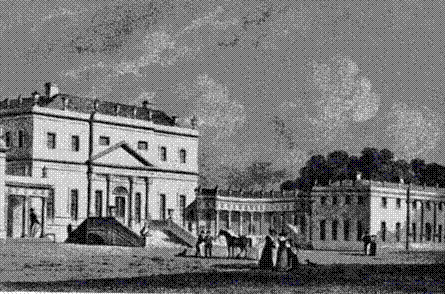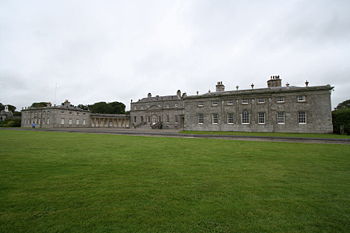
Russborough House
Encyclopedia

County Wicklow
County Wicklow is a county in Ireland. It is part of the Mid-East Region and is also located in the province of Leinster. It is named after the town of Wicklow, which derives from the Old Norse name Víkingalág or Wykynlo. Wicklow County Council is the local authority for the county...
, Ireland
Republic of Ireland
Ireland , described as the Republic of Ireland , is a sovereign state in Europe occupying approximately five-sixths of the island of the same name. Its capital is Dublin. Ireland, which had a population of 4.58 million in 2011, is a constitutional republic governed as a parliamentary democracy,...
, between the towns of Blessington
Blessington
Blessington, historically known as Ballycomeen , is a town in County Wicklow, Ireland. It is located on the N81 road, which connects Dublin to Tullow.- History :...
and Ballymore Eustace
Ballymore Eustace
Ballymore Eustace is a small town situated in County Kildare in Ireland, although until 1836 it lay within a "pocket" of County Dublin...
and is reputed to be the longest house in Ireland, with a frontage measuring 210 m/700 ft. It is an example of Palladian architecture
Palladian architecture
Palladian architecture is a European style of architecture derived from the designs of the Venetian architect Andrea Palladio . The term "Palladian" normally refers to buildings in a style inspired by Palladio's own work; that which is recognised as Palladian architecture today is an evolution of...
, designed by Richard Cassels
Richard Cassels
Richard Cassels , who anglicised his name to Richard Castle, ranks with Edward Lovett Pearce as one of the greatest architects working in Ireland in the 18th century. Cassels was born in 1690 in Kassel, Germany. Although German, his family were of French origin, descended from the...
for Joseph Leeson, 1st Earl of Milltown
Joseph Leeson, 1st Earl of Milltown
Joseph Leeson, 1st Earl of Milltown was an Irish peer and politician.-Background:He was the son of Joseph Leeson, who was a brewer in Dublin, and Mary Brice, daughter of Alderman Andrew Brice, Sheriff of Dublin...
and built between 1741 and 1755. The interior of the house contains some ornate plasterwork on the ceilings by the Lafranchini brothers
Lafranchini brothers
The Lafranchini brothers, originally from Switzerland, are famed today for their work in rococo style stucco, chiefly in the great palladian houses of Ireland....
, who also collaborated with Cassels on Carton House
Carton House
Carton House was one of Ireland's greatest stately homes and one time ancestral seat of the Earls of Kildare and Dukes of Leinster. Located west of Dublin, in Maynooth, County Kildare, the Carton demesne runs to 1,100 acres . For two hundred years it possessed the finest example in Ireland of a...
.
Russborough has housed two fine art collections, begun with the Milltown estate, whose collection was donated to the National Gallery of Ireland
National Gallery of Ireland
The National Gallery of Ireland houses the Irish national collection of Irish and European art. It is located in the centre of Dublin with one entrance on Merrion Square, beside Leinster House, and another on Clare Street. It was founded in 1854 and opened its doors ten years later...
upon the death of the last Earl. Sir Alfred Beit bought the house in 1952 where he housed his own family's collection, comprising works by many great artists, including Goya, Vermeer, Peter Paul Rubens and Thomas Gainsborough
Thomas Gainsborough
Thomas Gainsborough was an English portrait and landscape painter.-Suffolk:Thomas Gainsborough was born in Sudbury, Suffolk. He was the youngest son of John Gainsborough, a weaver and maker of woolen goods. At the age of thirteen he impressed his father with his penciling skills so that he let...
. This collection was since robbed four times, in 1974 by an IRA gang including British heiress Rose Dugdale
Rose Dugdale
Bridget Rose Dugdale , better known as Rose Dugdale, is a former debutante who rebelled against her wealthy upbringing, becoming a volunteer in the militant Irish republican organisation, the Provisional Irish Republican Army...
, in 1986 by Martin Cahill
Martin Cahill
Martin "The General" Cahill was a prominent Irish criminal from Dublin.Cahill generated a certain notoriety in the media, which referred to him by the sobriquet "The General". The name was also used by the media in order to discuss Cahill's activities while avoiding legal problems with libel...
(nicknamed "The General"), in 2001, and in 2002 by Martin Cahill's old associate Martin Foley . Two paintings, Gainsborough's Madame Bacelli and Vermeer's Lady writing a Letter with her Maid, the latter probably the most valuable painting of the collection, were stolen twice across the thefts, although each was subsequently recovered. The Beit collection has donated many of its works to the state and the house remains open to the public, having been opened by the Alfred Beit Foundation in 1978.

Amongst the paintings returned are four Claude Joseph Vernet paintings entitled ‘Morning’ ‘Midday’ ‘Sunset’ and ‘Night’. These paintings were actually painted for Russborough in the 1750s and had remained in the house for most of the last 260 years. Vermeer's Lady Writing a Letter With Her Maid and Goya's Portrait of Dona Antonia Zarate were recovered in 1993.
In recent years locally advertised Farmers Markets have been held on a regular basis in the grounds of the house.
On February 7, 2010, a fire severely damaged the west wing and caused part of the roof to collapse. No art was damaged, being removed along with furniture to allow for restorations to the west wing. Initial examinations of the damage suggested an electrical fault from wiring in the roof may have sparked the fire.
Sources
External links
- Russborough House - official site

